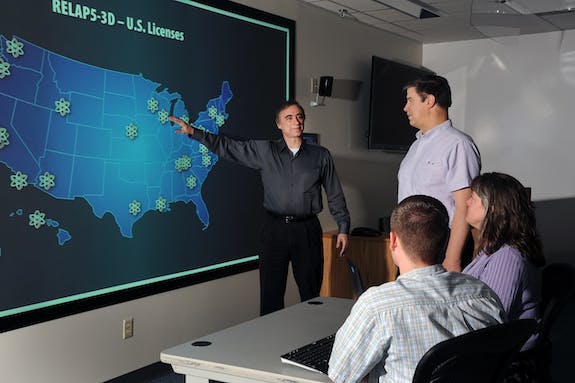A lot can change in 50 years. Just ask a carmaker, a telephone operator or any middle-aged adult. Like other creations from 1966, Idaho National Laboratory’s most successfully licensed invention — a reactor safety code — has evolved a lot since its inception.
INL developed the Reactor Excursion and Leak Analysis Program (RELAP) because the Nuclear Regulatory Commission needed a way to model nuclear reactor coolant and core behavior in a pressurized water reactor, especially during abnormal conditions. Today, RELAP is used throughout the world to support reactor safety analysis, reactor design, university education and operator training.
Nuclear reactor operators typically spend one week per month in the plant’s simulator to prepare to handle normal and unusual plant conditions. The simulator, an exact replica of the power plant control room, feeds directly to a computer running reactor simulation software that calculates plant reactions. Three simulator companies have coupled RELAP5-3D with other codes to simulate nuclear power plants.

After generations of updates, the current code, RELAP5-3D, can model all types of advanced reactors, regardless of the fuel or coolant technology used, as well as some other unlikely phenomena. Here are five other surprising uses.
It can model reactors under acceleration.
Though most of today’s commercial power reactors are considered stationary, reactors can be vibrated by an earthquake, which is a form of acceleration.
It can model blood flow through arteries and veins.
In many ways, coolant flowing through a reactor can resemble pulsing blood flow in a human body. When the National Institutes of Health asked INL to help develop its whole body model, INL programmers added flexible walls to the RELAP5-3D pipe model and added human blood as a working fluid. That made it possible to calculate the expansion and contraction of veins and arteries with heartbeats.
It plays well with others.
For more complex problems, RELAP5-3D can be combined with other programs designed to model different physical phenomena, such as instrumentation and controls, electricity generation, or conditions in the nuclear containment building. The problem is divided into locations where each program is best suited for modeling the physics, then the programs exchange necessary data through the RELAP5 executive program.
It is INL’s most licensed technology.
RELAP5-3D reached a milestone in 2017 when it signed its 100th active license agreement (it now has 102). Since the most recent version was introduced in 1996, RELAP5-3D has become one of the most widely licensed software products within the U.S. Department of Energy. Use of the code nearly doubled from 2012 to 2017 and continues to grow. International and domestic licensees include universities, government agencies, nuclear steam supply system providers and utilities with operating power plants. Membership fees from the International RELAP Users Group (IRUG) provide funding to continually upgrade and maintain the code.
It can model a reactor on a lengthy interplanetary trip.
Recent improvements to RELAP5-3D have given the code the ability to model long-duration events such as a trip to Mars. Getting RELAP5-3D coupled with other programs to model spaceship and reactor conditions for such a prolonged journey was challenging. RELAP5 was designed to model operational transients and accident scenarios that last for seconds to days, not three years like a round trip to Mars could take. This was one of the hardest upgrades of all time. Now, though, it’s possible to calculate the trip to Mars … and maybe even anywhere in the solar system!







